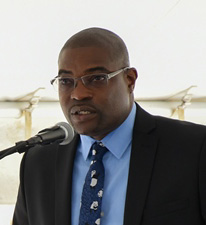If the Guyana Power and Light Company (GPL) had stuck to a proposed plan that would have seen it add between 20 to 25 mega-watts of power annually to the grid, it would not be in the “dilemma” it is in and rushing to buy reconditioned generator sets to meet increased demands, former minister of Public Works David Patterson said yesterday.
And knowing that the country was on a trajectory to decrease the use of heavy fuels, the generator sets would have been dual powered to allow for the changeover, instead of continuing with HFO usage, as will be the case with the 17 used generators GPL said it was procuring from Honduras, Patterson contended.
“They used a power generating study we had left to justify the gas to power project. However, that same study showed that we needed 20MW to 25MW per annum since 2018, to keep with normal average demand. As a good government they should have put measures in place to have at least 15 to 20 [MW] per year, up to this point and to keep up with the demand,” Patterson told the Stabroek News yesterday.
Referring to an article published in the Sunday Stabroek, which stated that GPL was getting extra power for Christmas and had procured generators worth US$27 million from the Dominican Republic, Patterson said that had there been proper planning, there would have been no need to buy the refurbished machines.
The generators are being procured from Honduras and not the Dominican Republic as had been stated.
“Now that they are in crisis mode, they are rushing to buy reconditioned generators? Those generators are high speed or less fuel efficient and we had done away with buying or renting high speed gensets. Why go back to that now?” he questioned.
“The plan should have been to continue to add capacity where there should have been an increase until the gas-to-shore project comes on stream. Not… that you drop everything and just wait on the gas to shore to solve everything. You still had to plan because every day [life] continues,” he added.
And where his government was blamed for not doing enough, Patterson rubbished the claims saying, “If we didn’t buy that 63MW generators, this country would have been in a worse state. The last power entered into GPL system came from us and they can’t dispute that. And to think that was since 2019,” he stressed.
“There is a narrative… ‘the coalition did nothing’. How can they [say that]? Plus that they would have been aware there was to be continuous upgrade of the system. This government has opened malls and added this and that with fanfare and not a single megawatt of power since then, but then blaming us with total untruths? They should have planned,” he emphasized.
President Irfaan Ali claimed that the APNU+AFC government left the main utility company in a state, and without a plan, but Patterson referred to a letter he had written in 2021 saying, “All that I said then, I repeat.
“The PM is quoted as saying the new 46.5MW power generators currently being installed are ‘part of the government’s plan for reliable electricity’ – Hogwash!! What plan? Like every other sector in the country, there were no plans pre-2015 – absolutely nothing. Our electricity sector was on the verge of collapse by 2015. It was barely being powered by generating sets, some over 35 years old, which of course led to the complete unreliability of the system. The coalition administration spent the next five years from 2015 systematically rebuilding and improving the power sector using clear and workable solutions,” that letter had stated.
“In five years under the coalition administration, nine new generating sets totalling 63MW were purchased (Anna Regina – 5.4MW, Bartica – 3.4MW, Bellevue – 1.5MW, Canefield – 5.5MW and Garden of Eden [five sets] – 46.5MW). In 2015, the generating capacity of GPL was listed at 120 – 125MW, which means that in five short years, the coalition’s work increased the generating capacity of the company by 50%. Never in the history of the company has it enjoyed such a huge increase in generating capacity in such a short period. Even more impressive, was that this increase was financed without any external loans. Under the PPP, between 2007 and 2014, US$155 million in loans were taken on behalf of GPL. This entire amount was mismanaged due to a lack of vision and corruption, resulting in the broken system pre-2015. On average, US$22 million per year in loans was given to GPL during this period, yet our power sector was on life support in 2015. Not only was GPL able to increase their generating capacity by 50% in 5 years, but they started repaying the interest on these loans. Commencing in 2015, GPL started to repay the people of Guyana US$5 million per year towards this massive debt, and were still able to advance their work programme – that’s what having a sound and workable plan should be,” it added.
Patterson had said that GPL’s improvement was not only limited to procurement of generators, but during the same period, the company was also able to reduce its technical and commercial line losses by 5%, which resulted in annual savings of $450 million. The company also carried out an impressive maintenance programme some of which is outlined below: –
“Almost all the transmission lines, over 300km, were repaired or upgraded – despite the big lie by the PPP, that no maintenance work was done on the transmission lines in the last four years. This lie is being used as a pretext to hire foreign contractors at huge costs thus bypassing our local contractors and in-house staff, who were providing yeoman service until 2020.
• Construction of 16 km of new feeder cables between Vreed-en-hoop and Vriesland.
• Installation and upgrade of the express feeders on the Demerara Berbice Interconnected System.
• Installation of a new 13.8kv submarine cable between Vreed-en-Hoop and Princes Street to provide redundancy due to the very poorly thought out and installed cable between Vreed-en-Hoop and Kingston, a cable that continues to be damaged on a regular basis.
• Installation of 486 km of new primary distribution lines and upgrade of 272 km of primary distribution lines.
• Installation of 231 km of new secondary distribution lines and upgrade of 519 km of secondary distribution lines.
• Replacement of 87,717 service lines.
• Installation of 502 new transformers and replacement of 2,292 defective transformers.
• The 1.5MW hybrid solar power plant for Wakenaam.
• The 1MW hybrid solar power plant for Leguan
• The 4MW solar power plant for Fort Wellington.
• The 1.5MW solar power plant for Bartica.
• Construction of four new substations with associated high-voltage transmission lines.”
Patterson had said that during the five-year period, GPL also gave back to the communities. The company provided power to 60 unserved areas, benefitting 26,286 residents – this was done entirely at the expense of the company. He said the coalition administration removed “the PPP policy of having customers in unserved areas pay 25% of the capital costs for installation of power, a hardship policy which has resumed once again.”
And pointing to the plans that the coalition administration left in place, he had listed them.
“The Kingdom of Norway was so impressed with the coalition administration’s Energy Diversification Programme, our roadmap to transition from heavy fuel generation to 100% renewable energy (yes, the same study that the PPP claimed to have used to justify their proposed white elephant Wales Gas to Shore project), that they immediately committed to use some of the US$80 million, previously set aside for the equally short-sighted Amaila Falls Hydro to construct 3 x 10 MW solar farms. It will be interesting to see how the PPP will try to convince Norway to reallocate these funds back to the Amaila Falls project since Norway acknowledged that the coalition’s energy plans were far superior to anything that the PPP had conceived.”
GPL currently has a Development and Expansion Programme 2023-2027.
It referred to an advertised EPC (engineering, procurement, and construction) for a 25 MW of HFO fired plants to be installed at either Canefield or Columbia this year. This is in addition to a 25 MW generator to be installed at Columbia.
Additionally, in the same month, GPL advertised for the supply of a total of 25 MW HFO-fired firm power generating capacity through a power purchase agreement over a three-year period at Canefield. The request was for a barge or a land-based power plant to be interconnected with the Canefield Substation at the 69 kV voltage level.
“This additional 25 MW at Canefield would assist GPL in achieving its LOLP [loss of load probability] target,” the company said.
The advertisement also carried a similar request for New Sophia or Columbia to further assist GPL with achieving its LOLP target.
For New Sophia, only the interconnection of a barge could be accommodated. At Columbia, only a land-based power plant could be accommodated. In both cases, the point of interconnection is also expected to be at the 69 kV voltage level.
The decision to acquire additional megawatts came from the findings of an assessment by the company which said “Generation reserves will be violated from 2023 and onwards, becoming negative from 2024. A negative system reserve indicates that demand is greater than generation which leads to a generation shortfall.”
“The LOLP will be severely violated from year 2023 and onwards. This means that almost every day of year 2024 and onwards there will be blackouts unless more generation is added…,” it added.
The company also plans to connect approximately 43,017 new consumers to the grid for the period of the D&E 2023 to 2027. “This growth in new services recognizes the continued expansion of the housing sector, resulting from the allocation of land by the Government of Guyana for housing and the expansion of existing structures into multi-storey premises,” GPL stated.






